|

|
Did time travelers
visit the earth’s past? The evidence is overwhelming.
- Who
left the modern shoe prints found in stone more than
200 million years before man appeared and dinosaurs
roamed the planet?
- Who left the metallic spheres found in South
Africa... obviously made by man... but more than two
billion years before man evolved on the earth?
- Did modern humans meet their untimely death to
have their remains preserved in the earth, hundreds
of thousands of years before possible?
From where, or perhaps
"when," were advanced civilizations visiting our past thousand’s and
million’s of years before man appeared on the earth?
Explore the Possibilities and the fascinating scientific evidence.
These pages contain just the surface of the forbidden knowledge
being hidden and protected today... knowledge that suggests a strong
possibility that our views of human origins are either incorrect...
or maybe that time travelers have already visited Earth’s past.
|
The False
Front
Temporal anomalies are scattered throughout the world -- things that
could not possibly belong to the time period in which they were
found. Evidence exists of human civilization, artifacts and
technology out of time that are abundant, well researched and well
documented.
This forbidden knowledge is being protected and hidden from all of
us. Today’s popular view of modern human presence in the distant
past is a false front. The real truth is out there showing proof of
advanced technology and people millions of years before humanity is
stated to have evolved on the planet.
Why has the scientific establishment and government suppressed and
ignored these remarkable finds? Where did they come from? How did
they get there? Why are we suppressing this suggestive proof of
modern time travelers visiting our past?
As you study the forbidden knowledge on these pages a whole new
truth will emerge and become apparent to you... the truth that the
earth was visited or inhabited by modern humans using advanced
technology long before the appearance of the first humans as the
history books write today.

The chart above presents the accepted scientific view of evolution
on this planet... It shows human beings appearing on the earth about
1.6 million years ago, and human civilization just 10,000 years ago.
However, using accepted scientific methods numerous finds show
conclusive proof of modern humans and advanced civilizations present
or visiting the earth’s past long before this timeline represents as
possible. The proof is shocking! Scientific proof of visitors,
possibly time travelers, long before civilized man evolved on the
planet.
From where, or perhaps "when," were advanced civilizations visiting
our past thousands or millions of years before man appeared on the
earth? As we move further back in time through the different eras,
you will see evidence continue to grow... evidence showing proof of
modern humans and technology in the distant past.
Go Back
Cenozoic
Era Proof
The Cenozoic Era is last of the five major eras of geologic time,
beginning about 65 million years ago and extending through the
present. It follows the Cretaceous period of the
Mesozoic era and is
subdivided into the Tertiary period and the Quaternary period.
Features of Tertiary times are considered in articles under the
names of the various shorter time periods (epochs) making up the
Tertiary period; in order, from earliest to latest, these are the
Paleocene, Eocene, Oligocene, Miocene, and Pliocene.
The accepted scientific view of evolution in the Cenozoic Era shows
human beings appearing on the earth about 1.6 million years ago, and
human civilization just 10,000 years ago. Yet the scientific finds
presented below present a very shocking and different story.
Pleistocene Epoch Finds
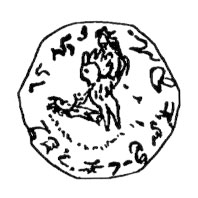 Copper Coin from Illinois, over 200,000 years old Copper Coin from Illinois, over 200,000 years old
This rendition of a coin-like object, from a well boring near
Lawn
Ridge, Illinois, was found at a depth of about 114 feet below the
surface.
According to the information supplied by the Illinois State
Geological Survey, the deposits containing the coin are between
200,000 and 400,000 years old... who left this coin hundreds of
thousands of years before civilized man evolved?
Modern Human Skeleton from Tanzania, over 800,000 years old
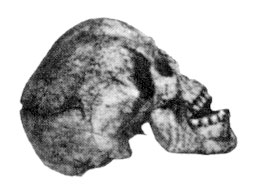 In 1913
Professor Hans Reck, of Berlin University, conducted
investigations at Olduvai Gorge in Tanzania, then German East
Africa. During his stay at Olduvai Gorge, Reck found a modern human
skeleton that remains a source of mystery and controversy to this
day. In 1913
Professor Hans Reck, of Berlin University, conducted
investigations at Olduvai Gorge in Tanzania, then German East
Africa. During his stay at Olduvai Gorge, Reck found a modern human
skeleton that remains a source of mystery and controversy to this
day.
This modern skull is from a fully human skeleton found that
year. The human skeletal remains, including this complete skull,
were cemented in the rock and had to be chipped with hammers and
chisels. It was found in the upper end of a rock bed dated at more
than 1,000,000 years old.
How did this modern human find his way
1,000,000 years into the past?
 Willendorf Venus Statue, over 30,000 years old Willendorf Venus Statue, over 30,000 years old
The Willendorf Venus, from Europe, dated at 30,000 years old. Who
created or left this artifact nearly 20,000 years before human
civilization appeared?
Modern Human Skull in Buenos Aires, over 1,000,000 years old
 In
1896, workers excavating a dry dock in Buenos Aires found a
modern human skull. The Pre-Ensenadan stratum in which the Buenos
Aires skull was found is a least 1.0 - 1.5 million years old. In
1896, workers excavating a dry dock in Buenos Aires found a
modern human skull. The Pre-Ensenadan stratum in which the Buenos
Aires skull was found is a least 1.0 - 1.5 million years old.
Even
at 1 million years the presence of a fully modern human skull
anywhere in the world is highly anomalous.
Why and how did a modern
human arrive in Buenos Aires over 1,000,000 years ahead of its time?
Pliocene Epoch Finds
Figurines from Nampa, Idaho, about 2 million years old
 A small human image, skillfully formed in clay, was found in
1889 at
Nampa, Idaho. The figurine came from the the 300-foot level of a
well boring and dated to be of the Plio-Pleistocene age, about 2
million years old. G. F. Wright noted, A small human image, skillfully formed in clay, was found in
1889 at
Nampa, Idaho. The figurine came from the the 300-foot level of a
well boring and dated to be of the Plio-Pleistocene age, about 2
million years old. G. F. Wright noted,
"The image is about an inch
and a half long; and remarkable for the perfection with which it
represents the human form... It was a female figure, and had the
lifelike lineaments in the parts which were finished that would do
credit to the classic centers of art."
Upon showing the object to
Professor F. W. Putnam," wrote Wright, "he at once directed
attention to the character of the incrustations of iron upon the
surface as indicative of a relic of considerable antiquity. There
were patches of anhydrous red oxide of iron in protected places upon
it, such as could not have been formed upon any fraudulent object."
Humans had not even evolved on this planet two million years ago. So
who created or left this artifact in earth’s distant past?
Modern Human Skull found in Italy, over 3 - 4 million years old
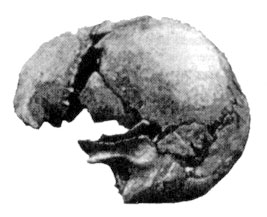 Late in the summer of 1860,
Professor Giuseppe Ragazzoni, a
geologist and teacher at the Technical Institute of Brescia,
traveled to the nearby locale of Castenedolo, about 10 kilometers
southeast of Brescia, to gather fossil shells in the Pliocene strata
exposed in a pit at the base of a low hill, the Colle de Vento. Late in the summer of 1860,
Professor Giuseppe Ragazzoni, a
geologist and teacher at the Technical Institute of Brescia,
traveled to the nearby locale of Castenedolo, about 10 kilometers
southeast of Brescia, to gather fossil shells in the Pliocene strata
exposed in a pit at the base of a low hill, the Colle de Vento.
Here
he discovered this remarkable and anatomically modern human skull.
The stratum from which it was taken is assigned to the Astian stage
of the Pliocene. According to modern authorities, the Astian belongs
to the Middle Pliocene, which would give the skull an age of 3 - 4
million years.
Why and how did this modern human visit Italy nearly
two million years before human beings walked the planet?
Carved Shell from the Red Crag, England, between 2.0 and 2.5
million years old
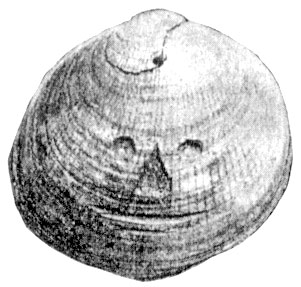 In a report delivered to the British Association for the Advancement
of Science in 1881, H. Stopes, F.G.S. (Fellow of the Geological
Society), described a shell, the surface of which bore a carving of
a crude but unmistakably human face. The carved shell was found in
the stratified deposits of the Red Crag. In a report delivered to the British Association for the Advancement
of Science in 1881, H. Stopes, F.G.S. (Fellow of the Geological
Society), described a shell, the surface of which bore a carving of
a crude but unmistakably human face. The carved shell was found in
the stratified deposits of the Red Crag.
The Red Crag, part of which
is called the Walton Crag, is dated to be of Late Pliocene age
between 2.0 and 2.5 million years old. This find would place
intelligent beings in England as far back as 2.0 million and maybe
as much as 2.5 million years ago.
One should keep in mind that in
terms of conventional paleoanthropoligical opinion, one does not
encounter such works of art until the time of fully modern
Cro-Magnon man in the Late Pleistocene, about 30,000 years ago.
What
visitor to Earth’s distant past carved and left this shell?
Eocene Epoch Finds
Chalk Ball near Laon, France, 45 - 55 million years old
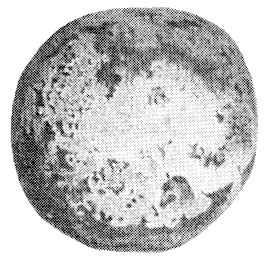 The April 1862 edition of
The Geologist included an English
translation of an intriguing report by Maximilien Melleville, the
vice president of the Societe Academique of Laon , France. This
chalk ball was discovered in an Early Eocene lignite bed. On the
basis of its stratigraphic position, is has been assigned a date of
45 - 55 million years ago. According to Melleville, there was no
possibility that the chalk ball was a forgery: The April 1862 edition of
The Geologist included an English
translation of an intriguing report by Maximilien Melleville, the
vice president of the Societe Academique of Laon , France. This
chalk ball was discovered in an Early Eocene lignite bed. On the
basis of its stratigraphic position, is has been assigned a date of
45 - 55 million years ago. According to Melleville, there was no
possibility that the chalk ball was a forgery:
"It really is
penetrated over four-fifths of its height by a black bituminous colour that merges toward the top into a yellow circle, and which is
evidently due to the contact of the lignite in which it had been for
so long a time plunged. The upper part, which was in contact with
the shell bed, on the contrary has preserved its natural colour --
the dull white of the chalk.... As to the rock in which it was
found, I can affirm that it is perfectly virgin, and presents no
trace whatever of any ancient exploitation.
As extraordinary as it
might seem to those attached to standard evolutionary views, the
evidence associated in this find suggest that if humans made the
ball, they must have been in France 45 - 55 million years ago.
Who
made and left this man made artifact in our past long before human
evolution... even before grazing and carnivorous mammals walked the
planet?
Mortar and Pestle in California, up to 55 million years old
 In 1877
Mr. J. H. Neale was superintendent of the Montezuma Tunnel
Company, and ran the Montezuma tunnel into the gravel underlying the
lava of Table Mountain, Tuolumne County.... At a distance of between
1400 and 1500 feet from the mouth of the tunnel, or of between 200
and 300 feet beyond the edge of the solid lava, Mr. Neale saw
several spear-heads of some dark rock and nearly one foot in length.
On exploring further, he himself found a small mortar three or four
inches in diameter and of irregular shape. In 1877
Mr. J. H. Neale was superintendent of the Montezuma Tunnel
Company, and ran the Montezuma tunnel into the gravel underlying the
lava of Table Mountain, Tuolumne County.... At a distance of between
1400 and 1500 feet from the mouth of the tunnel, or of between 200
and 300 feet beyond the edge of the solid lava, Mr. Neale saw
several spear-heads of some dark rock and nearly one foot in length.
On exploring further, he himself found a small mortar three or four
inches in diameter and of irregular shape.
This was discovered
within a foot or two of the spear-heads. He then found a large
well-formed pestle and near by a large and very regular mortar. All
of these relics were found the same afternoon, and were all within a
few feet of one another and close to the bed-rock, perhaps within a
foot of it. Mr. Neale declares that it is utterly impossible that
these relics can have reached the position in which they were found
excepting at the time the gravel was deposited, and before the lava
cap formed.
The position of the artifacts in gravel close to the
bed-rock at Tuolumne Table Mountain indicates they were
33-55
million years old. Grazing and carnivorous mammals had not even
evolved on the planet at this time.
So who brought and left behind
these artifacts in California nearly 50 million years ago?
Sling Stone from Bramford, England, 5 - 50 million years old
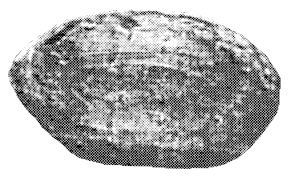 This sling stone is from the detritus bed beneath the Red Crag at
Bramford, England. At least Pliocene in age, the stone is
at least 5
million and possibly up to 50 million years old. Upon examination it
was obvious that the stone had been shaped by the hand of man....
The whole surface... has been scraped with a flint, in such a way
that it is covered with a series of facets running fairly regularly
from end to end.... This sling stone is from the detritus bed beneath the Red Crag at
Bramford, England. At least Pliocene in age, the stone is
at least 5
million and possibly up to 50 million years old. Upon examination it
was obvious that the stone had been shaped by the hand of man....
The whole surface... has been scraped with a flint, in such a way
that it is covered with a series of facets running fairly regularly
from end to end....
The scraping described above covers the whole
surface of the object, and penetrates into its irregularities. As it
stands the object is entirely artificial... yet left in a time
millions of years before humans had had even evolved on the Earth.
Go Back
Mesozoic
Era Proof
The Mesozoic Era is one of the major divisions of geological
history, following the Paleozoic era and preceding the Cenozoic era.
The Mesozoic era, which lasted from approximately 240 million to 65
million years ago, may be characterized as the Age of Reptiles
because their greatest development occurred during this era. The
first birds and mammals and the first flowering plants also appeared
at this time. The Mesozoic era is divided into three time periods:
the Triassic, Jurassic, and Cretaceous.
As we move back into time we enter a period in the Mesozoic Era that
began with the first dinosaurs appearing on the earth and ending
with the development of flowering plants. Humans wouldn’t evolve for
at least another 136 million years. Yet the scientific finds below
suggest proof that advanced civilizations were visiting Earth’s past
and walking at a time when dinosaurs roamed the planet.
Cretaceous Period
Metallic Tube at Saint-Jean de Livet, France over 65 million years
old
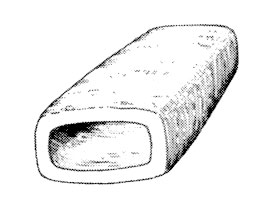 Y. Druet and
H. Salfati announced in 1968 the discovery of
semi-ovoid metallic tubes of identical shape but varying size in
Cretaceous chalk. Y. Druet and
H. Salfati announced in 1968 the discovery of
semi-ovoid metallic tubes of identical shape but varying size in
Cretaceous chalk.
The chalk bed, exposed in a quarry at Saint-Jean
de Livet, France, is estimated to be least 65 million years old.
Having considered and eliminated several hypotheses, Druet and
Salfati concluded that intelligent beings had lived 65 million years
ago.
Who brought and left behind these metallic tubes in France more
than 65 million years before the first human being would appear?
Triassic Period
Shoe Sole from Nevada, dated at 213 - 248 million years ago
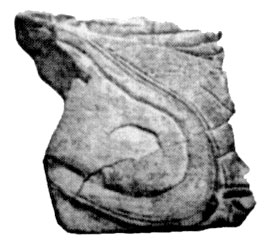 On October 8, 1922, the American Weekly section of the New York
Sunday American ran a prominent feature titled "Mystery of the
Petrified ’Shoe Sole," by Dr. W. H. Ballou. On October 8, 1922, the American Weekly section of the New York
Sunday American ran a prominent feature titled "Mystery of the
Petrified ’Shoe Sole," by Dr. W. H. Ballou.
Ballou wrote:
"Some time
ago, while he was prospecting for fossils in Nevada,
John T. Reid, a
distinguished mining engineer and geologist, stopped suddenly and
looked down in utter bewilderment and amazement at a rock near his
feet. For there, a part of the rock itself, was what seemed to be a
human footprint! Closer inspection showed that it was not a mark of
a naked foot, but was, apparently, a shoe sole which had been turned
into stone.
The forepart was missing. But there was the outline of
at least two-thirds of it, and around this outline ran a
well-defined sewn thread which had, it appeared, attached the welt
to the sole. Further on was another line of sewing, and in the
center, where the foot would have rested had the object really been
a shoe sole, there was an indentation, exactly such as would have
been made by the bone of the heel rubbing upon and wearing down the
material of which the sole had been made.
Reid got hold of a microphotographer and an analytical chemist of the
Rockefeller
Institute, who made photos and analyses of the specimen. The
analyses removed any doubt of the shoe sole having been subjected to
Triassic fossilization.... The microphoto magnifications are twenty
times larger than the specimen itself, showing the minutest detail
of thread twist and warp, proving conclusively that the shoe sole is
not a resemblance, but is strictly the handiwork of man. Even to the
naked eye the threads can be seen distinctly, along with the
definitely symmetrical outlines of the shoe sole. Inside this rim
and running parallel to it is a line which appears to be regularly
perforated as if for stitches.
The Triassic rock bearing the fossil
shoe sole is now recognized as being dated at 213 - 248 million
years old. An obviously modern shoe, complete with stitching, and
etched in time in ancient Triassic rock.
What modern visitor was
walking in our distant past more than 210 million years ago before
the age of the dinosaurs?
Go Back
Paleozoic
Era Proof
The Paleozoic Era is a major division of geological time, preceded
by Precambrian time and followed by the Mesozoic era, and including
the Cambrian, Ordovician, Silurian, Devonian, Carboniferous,
and Permian periods. The Paleozoic Era began about 570 million years ago
and ended about 240 million years ago.
As we move back even further in time we enter this period of the
Paleozoic Era where life was evolving from primitive, multicellular,
free-floating forms in the sea to advanced groups on land. The most
advanced life forms at the end of this period where amphibians,
insects, fern forests, and small reptiles. Humans would not evolve
for nearly another 300 million years. Yet the scientific finds below
again suggest even more strongly that modern humans with advanced
technology were visiting Earth’s past and walking at a time when the
first life forms were just beginning to emerge on our planet.
Carboniferous Period
Gold Thread in England, between 320 - 360 million years old
On June 22, 1844, this curious report appeared in the London Times:
"A few days ago, as some workmen were employed in quarrying a rock
close to the Tweed about a quarter of a mile below Rutherford-mill,
a gold thread was discovered embedded in the stone at a depth of
eight feet."
Dr. A. W. Medd of the British Geological Survey wrote
in 1985 that this stone is of Early Carboniferous age between
320
and 360 million years old.
Who dropped this gold thread in the
ancient fern forests in a distant time when the most advanced life
forms on the planet where amphibians and insects?
Gold Chain from Morrisonville, Illinois, 260 - 320 million years
old
On June 11, 1891, The Morrisonville Times reported:
"A curious find
was brought to light by Mrs. S. W. Culp last Tuesday morning. As she
was breaking a lump of coal preparatory to putting it in the
scuttle, she discovered, as the lump fell apart, embedded in a
circular shape a small gold chain about ten inches in length of
antique and quaint workmanship. At first Mrs.
Culp thought the chain
had been dropped accidentally in the coal, but as she undertook to
lift the chain up, the idea of its having been recently dropped was
at once made fallacious, for as the lump of coal broke it separated
almost in the middle, and the circular position of the chain placed
the two ends near to each other, and as the lump separated, the
middle of the chain became loosened while each end remained fastened
to the coal.
The lump of coal from which this chain was taken is
supposed to come from the Taylorville or Pana mines (southern
Illinois) and almost hushes one’s breath with mystery when it is
thought for how many long ages the earth has been forming strata
after strata which hid the golden links from view. The chain was an
eight-carat gold and weighed eight penny-weights."
The Illinois
State Geological Survey has said the coal in which the gold chain
was found is 260 - 320 million years old. This raises the
possibility that culturally advanced human beings were present or
visiting in North America during that time.
How did this gold chain
find itself left behind in Earth’s distant past more than a quarter
of a billion years before humans had evolved?
Carved Stone near Webster, Iowa, 260 - 320 million years old
The April 2,1897 edition of the Daily News of Omaha, Nebraska,
carried an article titled "Carved Stone Buried in a Mine," which
described an object from a mine near Webster City, Iowa. The article
stated:
"While mining coal today in the Lehigh coal mine, at a depth
of 130 feet, one of the miners came upon a piece of rock which
puzzles him and he was unable to account for its presence at the
bottom of the coal mine. The stone is of a dark grey color and about
two feet long, one foot wide and four inches in thickness. Over the
surface of the stone, which is very hard, lines are drawn at angles
forming perfect diamonds. The center of each diamond is a fairly
good face of an old man having a peculiar indentation in the
forehead that appears in each of the pictures, all of them being
remarkably alike. Of the faces, all but two are looking to the
right.
Was this stone carved and left behind by a traveler from
earth’s future?
Iron Cup from Oklahoma Coal Mine, 312 million years old
On November 27, 1948 the following statement was made by Frank J.
Kenwood in Sulphur Springs, Arkansas.
"While I was working in the
Municipal Electric Plant in Thomas, Oklahoma in 1912, I came upon a
solid chunk of coal which was too large to use. I broke it with a
sledge hammer. This iron pot fell from the center leaving the
impression mould of the pot in the piece of coal. Jim Stall (an
employee of the company) witnessed the breaking of the coal, and saw
the pot fall out. I traced the source of the coal, and found that it
came from the Wilburton, Oklahoma, Mines. According to Robert O. Fay
of the Oklahoma Geological Survey, the Wilburton mine coal is about
312 million years old.
What advanced civilization or visitor was
creating or using iron pots in our past more than 300 million years
ago?
Block Wall in an Oklahoma Mine, at least 286 million years old
W. W. McCormick of Abilene, Texas, reported his grandfather’s
account of a stone block wall that was found deep within a coal
mine:
"In the year 1928, I,
Atlas Almon Mathis, was working in coal
mine No. 5., located two miles north of Heavener, Oklahoma. This was
a shaft mine, and they told us it was two miles deep. The mine was
so deep that they let us down into it on an elevator.... They pumped
air down to us, it was so deep." One evening, Mathis was blasting
coal loose by explosives in "room 24" of this mine.
"The next
morning," said Mathis, "there were several concrete blocks laying in
the room. These blocks were 12-inch cubes and were so smooth and
polished on the outside that all six sides could serve as mirrors.
Yet they were full of gravel, because I chipped one of them open
with my pick, and it was plain concrete inside."
Mathis added: "As I
started to timber the room up, it caved in; and I barely escaped.
When I came back after the cave-in, a solid wall of these polished
blocks was left exposed. About 100 to 150 yards farther down our air
core, another miner struck this same wall, or one very similar."
The
coal in the mine was Carboniferous, which would mean the wall was at
least 286 million years old. According to Mathis, the mining company
officers immediately pulled the men out of the mine and forbade them
to speak about what they had seen. Mathis said the Wilburton miners
also told of finding "a solid block of silver in the shape of a
barrel... with the prints of the staves on it," in an area of coal
dating between 280 and 320 million years ago.
What advance
civilization built this wall?... Why was the truth, as is so many of
these cases protected and hidden?... What is the real truth about
time travelers, modern humans, and modern technology in our past?
Hieroglyphics in Ohio Coal Mine, 260 million year old
It is reported that James Parsons, and his two sons, exhumed a slate
wall in a coal mine at Hammondville, Ohio, in 1868. It was a large
smooth wall, disclosed when a great mass of coal fell away from it,
and on its surface, carved in bold relief, were several lines of
hieroglyphics.
Who carved these hieroglyphics more than 250 years
before humans walked the earth?
Devonian Period
Nail in Devonian Sandstone, between 360 and 408 million years old
In 1844, Sir David Brewster reported that a nail had been discovered
firmly embedded in a block of sandstone from the Kingoodie (Mylnfield)
Quarry in North Britain. Dr. A. W. Medd of the British Geological
Survey recently indicated that this sandstone is of "Lower Old Red
Sandstone age" (Devonian, between 360 and 408 million years old). In
his report to the British Association for the Advancement of
Science, Brewster stated:
"The particular block in which the nail
was found, was nine inches thick, and in proceeding to clear the
rough rock for dressing, the point of the nail was found projecting
about half an inch (quite eaten with rust) into the ’till,’ the rest
of the nail lying along the surface of the stone to within an inch
of the head, which went right down into the body of the stone."
The
fact that the head of the nail was buried in the sandstone block
would seem to rule out the possibility the nail had been pounded
into the block after it was quarried. This was a time where
amphibians and insects were the only dominant life form on our
planet.
So who dropped this nail to have it eventually preserved in
rock at a time more than 350 million years before humans appeared?
Cambrian Period
Shoe Print in Utah Shale, 505 to 590 Million Years Old
 In 1968,
William J. Meister, a draftsman and amateur trilobite
collector, reported finding a shoe print in the Wheeler Shale near
Antelope Spring, Utah. This shoe-like indentation and its cast were
revealed when Meister split open a block of shale. Clearly visible
within the imprint were the remains of trilobites, extinct marine
arthropods. The shale holding the print and the trilobite fossils is
from the Cambrian, and would thus be 505 to 590 million years old.
Meister described the ancient shoe-like impression in an article
that appeared in the Creation Research Society Quarterly: In 1968,
William J. Meister, a draftsman and amateur trilobite
collector, reported finding a shoe print in the Wheeler Shale near
Antelope Spring, Utah. This shoe-like indentation and its cast were
revealed when Meister split open a block of shale. Clearly visible
within the imprint were the remains of trilobites, extinct marine
arthropods. The shale holding the print and the trilobite fossils is
from the Cambrian, and would thus be 505 to 590 million years old.
Meister described the ancient shoe-like impression in an article
that appeared in the Creation Research Society Quarterly:
"The heel
print was indented in the rock about an eighth of an inch more than
the sole. The footprint was clearly that of the right foot because
the sandal was well worn on the right side of the heel in the
characteristic fashion."
At this time in our planet’s history there
was no plant or animal life on the land, even the most early types
of fish swimming in the seas had not yet evolved. It must have been
a very barren landscape that this visitor to Earth’s past saw as he
walked the land.
How did he arrive so far into our past?
Pre-Cambrian Period
Metallic Vase from Pre-Cambrian Rock, over 600 Million Years Old
The following report, titled "A Relic of a Bygone Age," appeared in
the magazine Scientific American (June 5, 1852):
 "A few days ago a
powerful blast was made in the rock at Meeting House Hill, in
Dorchester, a few rods south of Rev. Mr. Hall’s meeting house. The
blast threw out an immense mass of rock, some of the pieces weighing
several tons, and scattered fragments in all directions. Among them
was picked a metallic vessel in two parts, rent asunder by the
explosion. On putting the parts together it formed a bell-shaped
vessel, 4-1/2 inches high, 6-1/2 inches at the base, 2-1/2 inches at
the top, and about an eighth of an inch in thickness. "A few days ago a
powerful blast was made in the rock at Meeting House Hill, in
Dorchester, a few rods south of Rev. Mr. Hall’s meeting house. The
blast threw out an immense mass of rock, some of the pieces weighing
several tons, and scattered fragments in all directions. Among them
was picked a metallic vessel in two parts, rent asunder by the
explosion. On putting the parts together it formed a bell-shaped
vessel, 4-1/2 inches high, 6-1/2 inches at the base, 2-1/2 inches at
the top, and about an eighth of an inch in thickness.
The body of
this vessel resembles zinc in color, or a composition metal, in
which there is a considerable portion of silver. On the side there
are six figures of a flower, or bouquet, beautifully inlaid with
pure silver, and around the lower part of the vessel a vine, or
wreath, also inlaid with silver. The chasing, carving, and inlaying
are exquisitely done by the art of some cunning workman. This
curious and unknown vessel was blown out of the solid pudding stone,
fifteen feet below the surface."
According to a recent U.S.
Geological Survey map of the Boston-Dorchester area, the pudding
stone, now called the Roxbury conglomerate, is of Precambrian age,
over 600 million years old. By standard accounts, life was just
beginning to form on this planet during the Precambrian.
But in the
Dorchester vessel we have evidence indicating the presence of
artistic metal workers in North America over 600 million years
before Leif Erikson. At this time in our planets history the was no
life on land, plant or animal. The most advance life-form at this
barren time in our planets history was simple algae floating in the
seas. Yet somehow through time this beautiful work or art was
brought and left behind and eventually buried and preserved in
ancient rock.
Did a time traveler from the earths future leave this
behind in the hopes of later discovery... in an attempt to help
ensure that the truth about time travel would one day be revealed?
Grooved Sphere from South Africa, 2.8 Billion Years Old
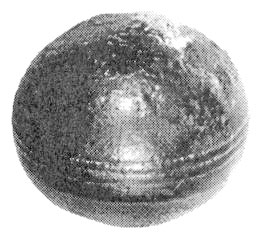 Over the past several decades,
South African miners have found
hundreds of metallic spheres, at least one of which has three
parallel grooves running around its equator. The spheres are of two
types -- "one of solid bluish metal with white flecks, and another
which is a hollow ball filled with a white spongy center." Roelf
Marx, curator of the museum of Klerksdorp, South Africa, where some
of the spheres are housed, said: Over the past several decades,
South African miners have found
hundreds of metallic spheres, at least one of which has three
parallel grooves running around its equator. The spheres are of two
types -- "one of solid bluish metal with white flecks, and another
which is a hollow ball filled with a white spongy center." Roelf
Marx, curator of the museum of Klerksdorp, South Africa, where some
of the spheres are housed, said:
"The spheres
(click image right)
are a complete
mystery. They look man-made, yet at the time in Earth’s history when
they came to rest in this rock no intelligent life existed. The
globes are found in pyrophyllite, which is mined near the little
town of Ottosdal in the Western Transvaal. This pyrophyllite is a
quite soft secondary mineral with a count of only 3 on the Mohs’
scale and was formed by sedimentation about 2.8 billion years ago.
On the other hand the globes are very hard and cannot be scratched,
even by steel."
The sphere with the three parallel grooves around it
are too perfect to be anything but man made. The Precambrian mineral
deposit where the globes are found is dated to be at least 2.8
billion years old. At this time simple microscopic cells were all
that was alive on the earth. But this is obviously not true.
Who
created or left behind these magnificent spheres. Obviously man
made, and stronger than steel, what was their purpose for the people
who visited and left them behind in time?
Go Back
Other
Finds
Artifacts From AIX En Provence, France
In his book Mineralogy, Count Bournon recorded an intriguing
discovery that had been made by French workmen in the latter part of
the eighteenth century. Bournon wrote:
"During the years 1786, 1787,
and 1788, they were occupied near AIX en Provence, in France, in
quarrying stone for the rebuilding , upon a vast scale, of the
Palace of Justice. The stone was a limestone of deep grey, and of
that kind which are tender when they come out of the quarry, but
harden by exposure to the air. The strata were separated from one
another by a bed of sand mixed with clay, more or less calcareous.
The first which were wrought presented no appearance of any foreign
bodies, but, after the workmen had removed the ten first beds, they
were astonished, when taking away the eleventh, to find its inferior
surface, at the depth of forty or fifty feet, covered with shells.
The stone of this bed having been removed, as they were taking away
a stratum of argillaceous sand, which separated the eleventh bed
from the twelfth, they found stumps of columns and fragments of
stone half wrought, and the stone was exactly similar to that of the
quarry: they found moreover coins, handles of hammers, and other
tools or fragments of tools in wood. But that which principally
commanded their attention, was a board about one inch thick and
seven or eight feet long; it was broken into many pieces, of which
none were missing, and it was possible to join them again one to
another, and to restore to the board or plate its original form,
which was that of the boards of the same kind used by the masons and
quarry men: it was worn in the same manner, rounded and waving upon
the edges."
Count Bournon, continuing his description, stated:
"The stones which
were completely or partly wrought, had not at all changed in their
nature, but the fragments of the board, and the instruments, and
pieces of instruments of wood, had been changed into
agate, which
was very fine and agreeably colored. Here then, we have the traces
of a work executed by the hand of man, placed at a depth of fifty
feet, and covered with eleven beds of compact limestone: everything
tended to prove that this work had been executed upon the spot where
the traces existed.
The presence of man had then preceded the
formation of this stone.
Letter-like Shapes in Marble, Philadelphia
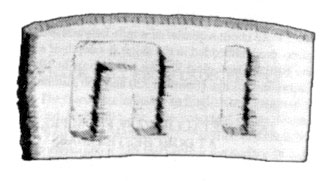 In 1830, letter-like shapes were discovered within a solid block of
marble from a quarry 12 miles northwest of Philadelphia. The marble
block was taken from a depth of 60-70 feet. This was reported in the
American Journal of Science (vol. 19, 1831, p. 361). The quarry
workers removed layers of gneiss, mica slate, hornblende, talcose
slate, and primitive clay slate before coming to the layer from
which the block containing the letter-like shapes were cut. In 1830, letter-like shapes were discovered within a solid block of
marble from a quarry 12 miles northwest of Philadelphia. The marble
block was taken from a depth of 60-70 feet. This was reported in the
American Journal of Science (vol. 19, 1831, p. 361). The quarry
workers removed layers of gneiss, mica slate, hornblende, talcose
slate, and primitive clay slate before coming to the layer from
which the block containing the letter-like shapes were cut.
While
they were sawing through the block, the workmen happened to notice a
rectangular indentation, about 1.5 inches wide by .625 inches high,
displaying two raised characters.
Several respectable gentlemen from
nearby Norristown, Pennsylvania, were called to the scene and
inspected the object. It is hard to explain the formation of the
characters as products of natural physical processes.
This suggests
the characters were made by intelligent humans in the distant past.
Go Back
|


 Copper Coin from Illinois, over 200,000 years old
Copper Coin from Illinois, over 200,000 years old  In 1913
Professor Hans Reck, of Berlin University, conducted
investigations at Olduvai Gorge in Tanzania, then German East
Africa. During his stay at Olduvai Gorge, Reck found a modern human
skeleton that remains a source of mystery and controversy to this
day.
In 1913
Professor Hans Reck, of Berlin University, conducted
investigations at Olduvai Gorge in Tanzania, then German East
Africa. During his stay at Olduvai Gorge, Reck found a modern human
skeleton that remains a source of mystery and controversy to this
day.
 Willendorf Venus Statue, over 30,000 years old
Willendorf Venus Statue, over 30,000 years old In
1896, workers excavating a dry dock in Buenos Aires found a
modern human skull. The Pre-Ensenadan stratum in which the Buenos
Aires skull was found is a least 1.0 - 1.5 million years old.
In
1896, workers excavating a dry dock in Buenos Aires found a
modern human skull. The Pre-Ensenadan stratum in which the Buenos
Aires skull was found is a least 1.0 - 1.5 million years old.
 A small human image, skillfully formed in clay, was found in
1889 at
Nampa, Idaho. The figurine came from the the 300-foot level of a
well boring and dated to be of the Plio-Pleistocene age, about 2
million years old. G. F. Wright noted,
A small human image, skillfully formed in clay, was found in
1889 at
Nampa, Idaho. The figurine came from the the 300-foot level of a
well boring and dated to be of the Plio-Pleistocene age, about 2
million years old. G. F. Wright noted,
 Late in the summer of 1860,
Professor Giuseppe Ragazzoni, a
geologist and teacher at the Technical Institute of Brescia,
traveled to the nearby locale of Castenedolo, about 10 kilometers
southeast of Brescia, to gather fossil shells in the Pliocene strata
exposed in a pit at the base of a low hill, the Colle de Vento.
Late in the summer of 1860,
Professor Giuseppe Ragazzoni, a
geologist and teacher at the Technical Institute of Brescia,
traveled to the nearby locale of Castenedolo, about 10 kilometers
southeast of Brescia, to gather fossil shells in the Pliocene strata
exposed in a pit at the base of a low hill, the Colle de Vento.
 In a report delivered to the British Association for the Advancement
of Science in 1881, H. Stopes, F.G.S. (Fellow of the Geological
Society), described a shell, the surface of which bore a carving of
a crude but unmistakably human face. The carved shell was found in
the stratified deposits of the Red Crag.
In a report delivered to the British Association for the Advancement
of Science in 1881, H. Stopes, F.G.S. (Fellow of the Geological
Society), described a shell, the surface of which bore a carving of
a crude but unmistakably human face. The carved shell was found in
the stratified deposits of the Red Crag.
 The April 1862 edition of
The Geologist included an English
translation of an intriguing report by Maximilien Melleville, the
vice president of the Societe Academique of Laon , France. This
chalk ball was discovered in an Early Eocene lignite bed. On the
basis of its stratigraphic position, is has been assigned a date of
45 - 55 million years ago. According to Melleville, there was no
possibility that the chalk ball was a forgery:
The April 1862 edition of
The Geologist included an English
translation of an intriguing report by Maximilien Melleville, the
vice president of the Societe Academique of Laon , France. This
chalk ball was discovered in an Early Eocene lignite bed. On the
basis of its stratigraphic position, is has been assigned a date of
45 - 55 million years ago. According to Melleville, there was no
possibility that the chalk ball was a forgery:
 In 1877
Mr. J. H. Neale was superintendent of the Montezuma Tunnel
Company, and ran the Montezuma tunnel into the gravel underlying the
lava of Table Mountain, Tuolumne County.... At a distance of between
1400 and 1500 feet from the mouth of the tunnel, or of between 200
and 300 feet beyond the edge of the solid lava, Mr. Neale saw
several spear-heads of some dark rock and nearly one foot in length.
On exploring further, he himself found a small mortar three or four
inches in diameter and of irregular shape.
In 1877
Mr. J. H. Neale was superintendent of the Montezuma Tunnel
Company, and ran the Montezuma tunnel into the gravel underlying the
lava of Table Mountain, Tuolumne County.... At a distance of between
1400 and 1500 feet from the mouth of the tunnel, or of between 200
and 300 feet beyond the edge of the solid lava, Mr. Neale saw
several spear-heads of some dark rock and nearly one foot in length.
On exploring further, he himself found a small mortar three or four
inches in diameter and of irregular shape.
 This sling stone is from the detritus bed beneath the Red Crag at
Bramford, England. At least Pliocene in age, the stone is
at least 5
million and possibly up to 50 million years old. Upon examination it
was obvious that the stone had been shaped by the hand of man....
The whole surface... has been scraped with a flint, in such a way
that it is covered with a series of facets running fairly regularly
from end to end....
This sling stone is from the detritus bed beneath the Red Crag at
Bramford, England. At least Pliocene in age, the stone is
at least 5
million and possibly up to 50 million years old. Upon examination it
was obvious that the stone had been shaped by the hand of man....
The whole surface... has been scraped with a flint, in such a way
that it is covered with a series of facets running fairly regularly
from end to end....
 Y. Druet and
H. Salfati announced in 1968 the discovery of
semi-ovoid metallic tubes of identical shape but varying size in
Cretaceous chalk.
Y. Druet and
H. Salfati announced in 1968 the discovery of
semi-ovoid metallic tubes of identical shape but varying size in
Cretaceous chalk.
 On October 8, 1922, the American Weekly section of the New York
Sunday American ran a prominent feature titled "Mystery of the
Petrified ’Shoe Sole," by Dr. W. H. Ballou.
On October 8, 1922, the American Weekly section of the New York
Sunday American ran a prominent feature titled "Mystery of the
Petrified ’Shoe Sole," by Dr. W. H. Ballou.
 In 1968,
William J. Meister, a draftsman and amateur trilobite
collector, reported finding a shoe print in the Wheeler Shale near
Antelope Spring, Utah. This shoe-like indentation and its cast were
revealed when Meister split open a block of shale. Clearly visible
within the imprint were the remains of trilobites, extinct marine
arthropods. The shale holding the print and the trilobite fossils is
from the Cambrian, and would thus be 505 to 590 million years old.
Meister described the ancient shoe-like impression in an article
that appeared in the Creation Research Society Quarterly:
In 1968,
William J. Meister, a draftsman and amateur trilobite
collector, reported finding a shoe print in the Wheeler Shale near
Antelope Spring, Utah. This shoe-like indentation and its cast were
revealed when Meister split open a block of shale. Clearly visible
within the imprint were the remains of trilobites, extinct marine
arthropods. The shale holding the print and the trilobite fossils is
from the Cambrian, and would thus be 505 to 590 million years old.
Meister described the ancient shoe-like impression in an article
that appeared in the Creation Research Society Quarterly:
 "A few days ago a
powerful blast was made in the rock at Meeting House Hill, in
Dorchester, a few rods south of Rev. Mr. Hall’s meeting house. The
blast threw out an immense mass of rock, some of the pieces weighing
several tons, and scattered fragments in all directions. Among them
was picked a metallic vessel in two parts, rent asunder by the
explosion. On putting the parts together it formed a bell-shaped
vessel, 4-1/2 inches high, 6-1/2 inches at the base, 2-1/2 inches at
the top, and about an eighth of an inch in thickness.
"A few days ago a
powerful blast was made in the rock at Meeting House Hill, in
Dorchester, a few rods south of Rev. Mr. Hall’s meeting house. The
blast threw out an immense mass of rock, some of the pieces weighing
several tons, and scattered fragments in all directions. Among them
was picked a metallic vessel in two parts, rent asunder by the
explosion. On putting the parts together it formed a bell-shaped
vessel, 4-1/2 inches high, 6-1/2 inches at the base, 2-1/2 inches at
the top, and about an eighth of an inch in thickness. 
 In 1830, letter-like shapes were discovered within a solid block of
marble from a quarry 12 miles northwest of Philadelphia. The marble
block was taken from a depth of 60-70 feet. This was reported in the
American Journal of Science (vol. 19, 1831, p. 361). The quarry
workers removed layers of gneiss, mica slate, hornblende, talcose
slate, and primitive clay slate before coming to the layer from
which the block containing the letter-like shapes were cut.
In 1830, letter-like shapes were discovered within a solid block of
marble from a quarry 12 miles northwest of Philadelphia. The marble
block was taken from a depth of 60-70 feet. This was reported in the
American Journal of Science (vol. 19, 1831, p. 361). The quarry
workers removed layers of gneiss, mica slate, hornblende, talcose
slate, and primitive clay slate before coming to the layer from
which the block containing the letter-like shapes were cut.